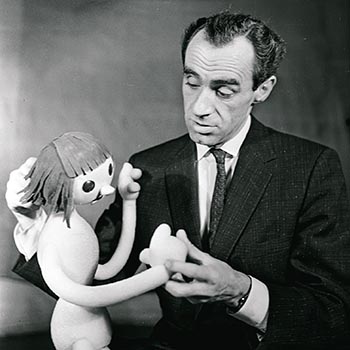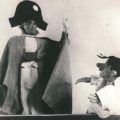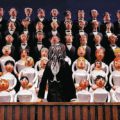Audrey Azoulay, Director-General of UNESCO, in her words of congratulations on the World Puppetry Day, noted that “today this fragile art is facing unprecedented trials”, and “it is our duty to preserve it”. In Russia, the history of a puppet theater is inextricably linked with the name of the outstanding director and actor Sergey Obraztsov.
Sergey Obraztsov was born on June 22, 1901 in Moscow in the family of a railway engineer and a teacher. In 1918 he entered the Art Faculty of the Higher Artistic and Technical Workshops, and in 1922 he became an actor in the Music Studio of the Moscow Art Theater (now the Moscow Academic Musical Theater).
All My Life I’ve Been Playing with Dolls
The first puppet appeared in the life of Sergey Obraztsov in early childhood, when his mother bought him a funny toy in a Japanese goods store. It was a head with a hole for a finger in a robe in the form of a glove. Once on the hand, the puppet came to life and could convey the entire palette of emotions that its owner was capable of.
Sergey began to make his own puppets while studying at the Higher Artistic and Technical Workshops. At that time it was not a creative impulse, but a vital necessity — Obraztsov and his friends were planning to make puppets for sale. However, things did not go well and the little puppet actors, still in the hands of their makers, began to amuse the first spectators — relatives, friends and classmates, acting out scenes and singing popular romances. Since Sergey knew many artists and actors, the performances became more and more important, and over time — semi-professional. The secret of the puppet performances success was that Obraztsov, with his sincerity and subtle humor, managed to win the trust of not only children, but also discerning adults.
The Birth of a Puppet Theater
In 1931, Sergey Obraztsov was summoned to the Central House of Artistic Education of Children to head the newly created Central Puppet Theater. The intend was to make the new theater a kind of base to set up a network of puppet theaters in the Soviet Union. In the first year of work, there were five actors, an artist and an accompanist in the team. Until 1936 the theater did not have its own place, so they played their shows wherever it was possible — in schools, institutes, parks, sanatoriums, hospitals, etc. In 1936, the theater found its first home, soon opening a museum of theater puppets and a library. Over the years, the troupe has grown, the repertoire has expanded, and new techniques for making puppets have been mastered. Thus, in 1940, Aladdin and the Magic Lamp play for adults was released, where rod puppets were used for the first time. The contemporaries called Sergey Obraztsov a “great taster”. That means, he had a unique ability to find the best actors, to attract playwrights and composers who created their works especially for the puppet theater, since “in a puppet theater one should stage only the plays that cannot be performed at human theater”. All plays of Sergey Obraztsov are permeated with satire and irony — his heroes ridicule false feelings and emotions, lies and banality, vulgarity and hypocrisy. The invariable serious expression on puppets faces when talking or singing adds the spice to the performance and causes violent laughter in the audience.
There Is Nothing More Important than Fight against Possible War
During the Great Patriotic War of 1941-1945, the Central Puppet Theater created front-line brigades that regularly performed at recruiting stations, barracks, factories, hospitals, and forest glades before the battle. For the seriously wounded, they gave performances right in the wards, and, according to Sergey Obraztsov, he never felt his profession more necessary than in those days when smiling faces looked at him from hospital beds.
In February 1945, Sergey Obraztsov was included in a concert group that went to Romania, Bulgaria and Yugoslavia liberated from the Nazis. Soviet actors were greeted very warmly in overcrowded halls. In 1948, the Central Puppet Theater visited Poland and Czechoslovakia, and in 1950 — the German Democratic Republic. The trip to the GDR psychologically was the most difficult for both sides, who had fought against each other just five years prior. From the first days of the tour, Soviet actors, musicians, stage workers, together with German film workers, worked on two movies based on the performances of the puppet theater — Aladdin and the Magic Lamp and Our Moscow Friends. A German cameraman, who had lost an arm near Voronezh, and a Soviet actor, who had a German bullet in his head, worked side by side. It was the work dedicated to friendship. Obraztsov believed that is what happiness is all about. “There is nothing more important than the fight against a possible war. For this world to exist, peoples must trust each other and be friends. But one cannot be friend theoretically, one cannot only declare friendship. It is necessary to meet hand in hand, eye to eye, and personal meetings are often no less important than official conferences.”
Sergey Obraztsov and his Theater
In 1946, the first post-war performance was staged called Unusual Concert, which brought the theater national fame and became its hallmark. The play entered the Guinness Book of Records as the production that was watched by the largest number of spectators in the world, and was performed more than nine thousand times in almost 90 countries. The main character of the Unusual Concert — entertainer Eduard Aplombov — always joked in the native language of the audience. Over the years, his role has been played by Zinovy Gerdt, the outstanding Soviet and Russian actor. The entire play is a great parody of actors of different genres, more precisely, of the banal stereotypes and clichés inherent in some music performances of those years. The play is still a success on the stage of the Central Puppet Theater named after Sergey Obraztsov, and the jokes of Eduard Aplombov have long became a part of everyday speech.
In 1970, the Puppet Theater moved to the Garden Ring in a new building. Its facade is decorated with a unique clock, designed on the Obraztsov’s initiative. The clock is a construction of twelve houses in which heroes from famous fairy tales “live”. Every hour a door opens to the music and a character comes out corresponding to it hour, and twice a day you can see all the characters at once.
Over the 60 years of his leadership of the theater, Sergey Obraztsov staged 61 performances, many of which were included in the golden fund of Russian and world theatrical art. He was a man of incredible creativity who came up with a unique puppet world. He was a master who raised his profession to a new level, created new techniques and educated several generations of brilliant puppeteers.
Through the Hearts of Children to the Hearts of Nations
Obraztsov went on tour with his theater in thirty-four countries of the world, and everywhere the performances were sold out. With the active participation of the Central Puppet Theater, there were puppet theaters created in a number of countries (Poland, Bulgaria, Hungary, Czechoslovakia). Since the mid-50s, the Obraztsov Theater has been a regular participant in international puppetry festivals. In 1976, during the twelfth congress of the Union Internationale de la Marionnette (UNIMA), which was held in Moscow, Obraztsov was elected its president and remained in this position until 1984. He received many state awards, but considered the most valuable for himself the Order of the Smile — a Polish order that was awarded to people who bring joy to children. Sergey Obraztsov always viewed the theater’s international activities as a fight for peace and friendship. A wonderful battle, the weapon of which is art: “It is necessary to understand that, no matter how people of separate nationalities may differ from each other, the most important thing is that in basic human properties they are the same. Only by understanding this, you can be an internationalist and fight for friendship between peoples”.
Darya Serzhenko
Photo: Museum of Puppet Theater named after Sergey Obraztsov
 Zinovy Gerdt (1916–1996)
Zinovy Gerdt (1916–1996)
He became a locksmith, worked as an electrician, and first appeared on the stage at the Theater of Working Youth, where he played in his free time. In 1935 he was included in the professional troupe of the theater. In 1941 he volunteered for the front, was seriously wounded in the leg by a shell fragment. In 1945, on crutches, he came to see Sergey Obraztsov and was accepted into the troupe of the theater, where he served for 36 years. His first role with a puppet was in 1946, when the premiere of the Unusual Concert took place and played it more than 500 times. Preparing for performances abroad, Gerdt not only learned the role in a foreign language, but also studied the local press in order to add jokes to the script later. In some performances, Zinovy played several characters at once, masterly changing the intonation of his voice. From 1983 to 1992 he was an actor of the Moscow Drama Theater named after Ermolova. He is known to Soviet and Russian audiences for his poignant roles in many of their favorite movies. He was fond of poetry, dance and jazz music.





